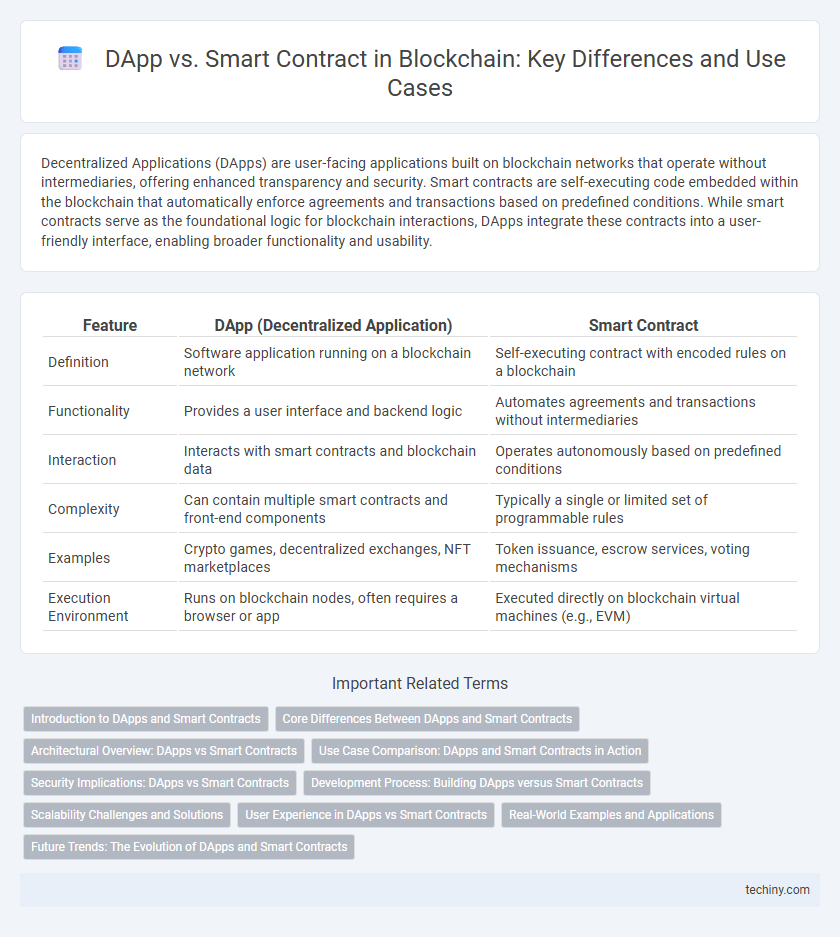Decentralized Applications (DApps) are user-facing applications built on blockchain networks that operate without intermediaries, offering enhanced transparency and security. Smart contracts are self-executing code embedded within the blockchain that automatically enforce agreements and transactions based on predefined conditions. While smart contracts serve as the foundational logic for blockchain interactions, DApps integrate these contracts into a user-friendly interface, enabling broader functionality and usability.
Table of Comparison
| Feature | DApp (Decentralized Application) | Smart Contract |
|---|---|---|
| Definition | Software application running on a blockchain network | Self-executing contract with encoded rules on a blockchain |
| Functionality | Provides a user interface and backend logic | Automates agreements and transactions without intermediaries |
| Interaction | Interacts with smart contracts and blockchain data | Operates autonomously based on predefined conditions |
| Complexity | Can contain multiple smart contracts and front-end components | Typically a single or limited set of programmable rules |
| Examples | Crypto games, decentralized exchanges, NFT marketplaces | Token issuance, escrow services, voting mechanisms |
| Execution Environment | Runs on blockchain nodes, often requires a browser or app | Executed directly on blockchain virtual machines (e.g., EVM) |
Introduction to DApps and Smart Contracts
Decentralized applications (DApps) operate on blockchain networks, leveraging smart contracts to execute predefined functions without centralized control. Smart contracts are self-executing code stored on the blockchain that automatically enforce and verify agreements when certain conditions are met. Together, DApps use smart contracts to enable transparent, trustless transactions and programmable business logic across decentralized ecosystems.
Core Differences Between DApps and Smart Contracts
DApps (Decentralized Applications) operate as full applications built on blockchain platforms, integrating multiple smart contracts to deliver user interfaces and complex functionalities. Smart contracts are self-executing code stored on the blockchain that automatically enforce and execute predefined rules without user intervention. The core difference lies in their scope: smart contracts handle individual, automated transactions, while DApps provide broader user-oriented applications that leverage these smart contracts for decentralized operations.
Architectural Overview: DApps vs Smart Contracts
DApps (Decentralized Applications) consist of frontend user interfaces paired with backend smart contracts deployed on blockchain networks, facilitating interactive and trustless user experiences. Smart contracts serve as self-executing code stored on the blockchain, automating transactions and logic without intermediaries. The architectural distinction lies in DApps integrating smart contracts with off-chain components for user interaction, while smart contracts alone function as immutable, decentralized protocols executing predefined rules.
Use Case Comparison: DApps and Smart Contracts in Action
DApps enable decentralized applications with user interfaces that interact directly with blockchain networks, facilitating complex use cases like decentralized finance (DeFi) platforms and NFT marketplaces. Smart contracts execute predefined logic autonomously on the blockchain, powering automated processes such as token transfers, voting systems, and escrow agreements. While smart contracts serve as the foundational code, DApps provide full-fledged ecosystems for user engagement and multi-layered functionalities.
Security Implications: DApps vs Smart Contracts
Smart contracts are self-executing code with predefined rules that run on blockchain networks, offering predictable and transparent security through immutability and cryptographic enforcement. Decentralized applications (DApps) leverage smart contracts but introduce additional attack surfaces due to their user interfaces and off-chain components, increasing overall security risks. Rigorous auditing of smart contract code combined with secure front-end development practices is crucial to mitigate vulnerabilities across both smart contracts and DApps.
Development Process: Building DApps versus Smart Contracts
Developing DApps involves creating a user interface, backend logic, and integrating smart contracts on blockchain platforms like Ethereum or Binance Smart Chain, requiring front-end frameworks such as React and blockchain frameworks like Truffle or Hardhat. Smart contract development focuses on writing decentralized code using languages like Solidity or Vyper, performing rigorous security audits, and deploying them directly onto the blockchain. The DApp development process is more complex due to the need for seamless interaction between front-end interfaces and blockchain-based smart contracts, while smart contract development centers primarily on secure and efficient blockchain code execution.
Scalability Challenges and Solutions
DApps face scalability issues due to network congestion and limited transaction throughput on blockchain platforms. Smart contracts contribute to these challenges by requiring significant computational resources, leading to slow execution times and high gas fees. Layer 2 solutions, sharding, and optimized consensus algorithms enhance scalability by enabling faster transactions and reducing network load for both DApps and smart contracts.
User Experience in DApps vs Smart Contracts
DApps offer a user-friendly interface with interactive features that enhance accessibility and engagement, making blockchain technology more approachable for non-technical users. Smart contracts execute predefined rules automatically but lack direct interaction options, requiring users to rely on external platforms or wallets for engagement. The seamless integration of front-end interfaces in DApps significantly improves user experience compared to the more technical and code-driven interaction with standalone smart contracts.
Real-World Examples and Applications
Decentralized applications (DApps) like Uniswap enable peer-to-peer cryptocurrency trading without intermediaries, showcasing practical blockchain use in finance. Smart contracts automate and enforce agreements, exemplified by Ethereum's ERC-20 token standard for creating cryptocurrencies and managing token transfers. Together, DApps and smart contracts drive innovations in sectors such as decentralized finance (DeFi), supply chain transparency, and digital identity verification.
Future Trends: The Evolution of DApps and Smart Contracts
DApps and smart contracts are rapidly evolving with advancements in blockchain scalability, interoperability, and user experience, driving mainstream adoption. Future trends indicate increased integration of artificial intelligence and cross-chain capabilities, enabling more complex and autonomous decentralized applications. Enhanced security frameworks and regulatory clarity will further accelerate the deployment of sophisticated smart contract-driven ecosystems.
DApp vs Smart Contract Infographic

 techiny.com
techiny.com